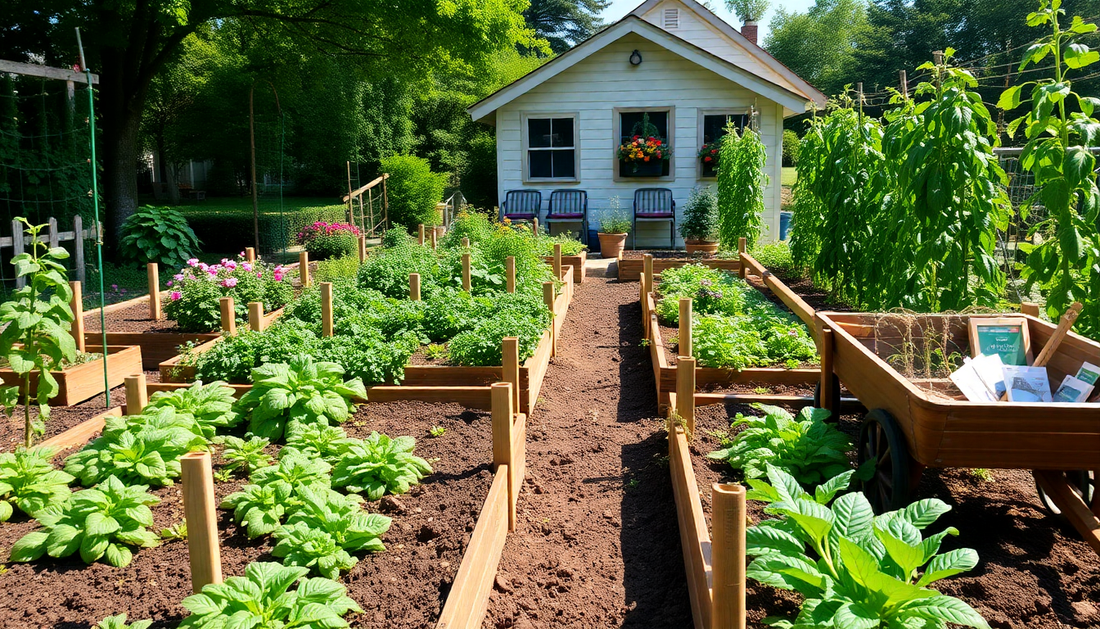
Vegetable Garden Planning for Beginners: A Step-by-Step Guide to Growing Your Own Produce
Share
Embarking on the journey of growing your own vegetables can be an incredibly rewarding experience, but it can also feel overwhelming, especially for beginners. Whether you have a small backyard, a balcony, or even just a sunny windowsill, there's a world of possibilities when it comes to cultivating a thriving vegetable garden. In this comprehensive guide, we'll walk you through the essential steps to plan and create a vegetable garden that will not only provide you with fresh, flavorful produce but also bring a sense of joy and accomplishment to your life.
Assessing Your Growing Conditions
The first step in planning your vegetable garden is to assess the growing conditions of your chosen space. This includes factors such as sunlight, soil quality, and available space. Understanding these elements will help you select the right plants and design a layout that maximizes your garden's potential.
Sunlight Requirements
Different vegetables have varying sunlight needs. Some, like tomatoes, peppers, and eggplants, thrive in full sun, requiring at least 6 hours of direct sunlight per day. Others, such as leafy greens and root vegetables, can tolerate partial shade. Evaluate the amount of sunlight your garden space receives throughout the day and choose your plants accordingly.
Soil Preparation
Healthy soil is the foundation of a successful vegetable garden. Test your soil's pH and nutrient levels to determine what amendments, if any, it may need. Incorporate organic matter, such as compost or well-rotted manure, to improve soil structure and fertility. This will provide your plants with the nutrients they need to grow strong and productive.
Available Space
Consider the size of your garden space and plan your layout accordingly. Raised beds, container gardens, and vertical gardening techniques can all be effective ways to maximize a small area. Determine the appropriate size and number of beds or containers to accommodate your desired plant selection.
Selecting Your Vegetables
Once you've assessed your growing conditions, it's time to choose the vegetables you want to grow. Consider factors such as your personal preferences, the climate in your region, and the season. Here are some popular vegetable options to consider:
Cool-Season Crops
These vegetables thrive in cooler temperatures and can be planted in early spring or late fall. Examples include lettuce, spinach, kale, radishes, and peas.
Warm-Season Crops
These plants prefer warmer weather and are typically planted after the last frost date. Examples include tomatoes, peppers, cucumbers, zucchini, and beans.
Succession Planting
To extend your harvest and avoid gluts of produce, consider incorporating succession planting into your garden plan. This involves planting the same crop at different intervals, allowing you to enjoy a continuous supply of fresh vegetables throughout the growing season.
Designing Your Garden Layout
With your growing conditions and vegetable selections in mind, it's time to design your garden layout. This step is crucial for maximizing your available space and ensuring a harmonious and productive garden.
Raised Beds or In-Ground Gardening
Raised beds offer several advantages, such as improved drainage, easier access, and the ability to control soil quality. If you have the space, in-ground gardening can also be an excellent option, allowing for larger planting areas.
Companion Planting
Companion planting is the practice of strategically placing certain plants next to each other to enhance their growth and deter pests. For example, planting marigolds alongside your tomatoes can help repel harmful insects.
Vertical Gardening
Incorporating vertical elements, such as trellises or cages, can help you make the most of your garden space. This is particularly useful for vining crops like cucumbers, pole beans, and tomatoes.
Crop Rotation
Rotating your crops from year to year can help prevent the buildup of pests and diseases, as well as maintain soil fertility. Group your vegetables into families and rotate them through different sections of your garden.
Planting and Maintenance
With your garden plan in place, it's time to start planting and maintaining your vegetable garden. Here are some key considerations:
Planting Schedules
Consult planting calendars and seed packets to determine the optimal planting times for your chosen vegetables. This will ensure that your plants are in the ground at the right time for their specific growth requirements.
Watering and Mulching
Consistent, appropriate watering is crucial for healthy plant growth. Mulching your garden beds with organic materials, such as straw or wood chips, can help retain soil moisture and suppress weed growth.
Pest and Disease Management
Vigilance and proactive measures are key to keeping your garden free from pests and diseases. Use organic pest control methods, such as hand-picking pests or introducing beneficial insects, and practice good sanitation to maintain a healthy growing environment.
Harvesting and Storage
Learn the appropriate harvest times for your vegetables and handle them with care to ensure maximum freshness and flavor. Proper storage techniques, such as refrigeration or canning, can help you enjoy your homegrown produce long after the harvest.
Embracing the Journey
Growing your own vegetables is a rewarding and empowering experience that can provide you with a bounty of fresh, nutritious produce. By following the steps outlined in this guide, you'll be well on your way to creating a thriving vegetable garden that will not only nourish your body but also your soul. Embrace the journey, celebrate your successes, and don't be afraid to learn from any challenges that arise. Happy gardening!
